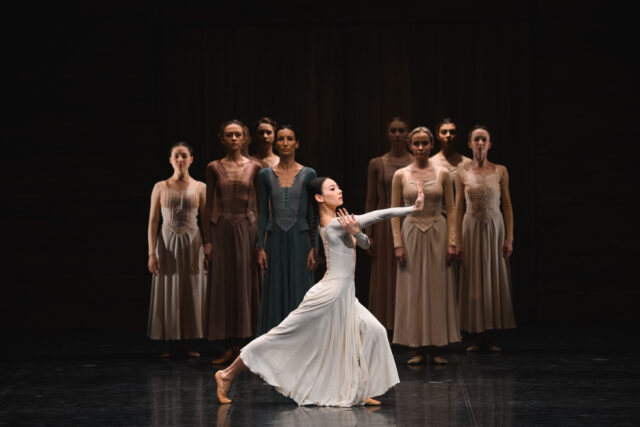
Svadebka (Les noces). The Second Detail

Choreographic scenes with singing and music to folk texts from the collection of Pyotr Kireevsky
Choreography by Jiří Kylián
First staged in 1982. This version was first performed in Perm in 2012. The 2022 revival
Stravinsky had the idea for a choral cantata to texts of Russian religious hymns in 1912, but did not really start work on the idea until 1914. Les noces, staged by Bronislava Nijinska, a choreographer with Sergei Diaghilev’s Ballets Russes, was a great success when it was first performed at the Théâtre de la Gaîté in Paris in 1923. Stravinsky’s score has inspired subsequent generations of choreographers, but perhaps the most successful interpretation was that of Jiří Kylián, who staged Svadebka (Les noces) at the Nederlands Dans Theater in 1982.
The very news that Kylián, a living legend of contemporary dance, had let the Perm Theatre have his celebrated ballet caused a great sensation among critics and ballet-lovers, as the choreographer had not previously given anyone in Russia permission to perform Svadebka. Three factors determined the issue in favour of the Perm production: the Perm company’s high technical capability, the live performance of the music (at a time when Kylián himself used a recording), and the remarkable story of the origin and development of ballet in Perm, a closed industrial city during the Soviet period.
Performed with permission from Chester Music Limited
One-act ballet by William Forsythe set to the music of Thom Willems
The ballet was first staged in 1991. It was first performed in Perm in 2012. The 2022 revival
William Forsythe — not a pupil of George Balanchine, but a disciple of his who has developed the idea of pure dance in his own way — is a living legend in the ballet world. He has been called a deconstructivist of academic dance, but companies all over the world regard it as an honour to have his productions in their repertoire. In Russia, only the Mariinsky Theatre (three ballets) and the Bolshoi Theatre (one ballet) have so far held this right.
Although from New York, Forsythe achieved his greatest successes in Europe. From 1984 to 2004, he headed the Frankfurt Ballet, earning it a reputation as one of the world’s most progressive ballet companies. In 2005, he formed his own company, the Forsythe Company, which is based in Dresden and Frankfurt-am-Main.
Forsythe composed The Second Detail at the height of his Frankfurt period in the early 1990s. Ballet historians characterize the spirit and style of those years as ‘late classical Forsythe’. To the inventive synthetic beat of Dutch composer Thom Willems, a regular collaborator of Forsythe, 14 dancers in simple sky-blue costumes illustrate the choreographer’s favourite device: the sudden generation of movement in various groups of the dance ensemble and their differing contrasts with one another. The Perm production of The Second Detail was the Russian première of this ballet
Performed with permission from Boosey & Hawkes Music Publishers Limited
The principal partners of the production are Mr. Toshihiko Takahashi and the LUKOIL Group in Perm Region
Stage Directors
Jiri Kylian
Director and choreographer
Elke Schepers
Assistant Choreographer
Philip Taylor
Assistant Choreographer
John F. Macfarlane
Set and Costume Designer
Jennifer Tipton
Lighting Designer
Joost Biegelaar
Technical Coordinator
The 2012 production Musical Director and Conductor
The 2012 production Chorus Master
Arina Zvereva
The 2012 production Chorus Master
The 2012 production Artistic Director
Artistic Director of the Renewal
Stage Directors
William Forsythe
Choreography
Thom Willems
Music
Issey Miyake (“White Dress”)
Costumes
Noah Gelber
Staged by
The 2012 production Artistic Director
Artistic Director of the Renewal
Other events







Svadebka (Les noces). The Second Detail


